+ Open data
Open data
- Basic information
Basic information
| Entry | Database: PDB / ID: 6yw6 | |||||||||||||||||||||||||||
|---|---|---|---|---|---|---|---|---|---|---|---|---|---|---|---|---|---|---|---|---|---|---|---|---|---|---|---|---|
| Title | Cryo-EM structure of the ARP2/3 1B5CL isoform complex. | |||||||||||||||||||||||||||
 Components Components |
| |||||||||||||||||||||||||||
 Keywords Keywords | STRUCTURAL PROTEIN / Cytoskeleton | |||||||||||||||||||||||||||
| Function / homology |  Function and homology information Function and homology informationtubulobulbar complex / meiotic chromosome movement towards spindle pole / cytosolic transport / growth cone leading edge / spindle localization / meiotic cytokinesis / actin polymerization-dependent cell motility / muscle cell projection membrane / asymmetric cell division / Arp2/3 protein complex ...tubulobulbar complex / meiotic chromosome movement towards spindle pole / cytosolic transport / growth cone leading edge / spindle localization / meiotic cytokinesis / actin polymerization-dependent cell motility / muscle cell projection membrane / asymmetric cell division / Arp2/3 protein complex / Arp2/3 complex-mediated actin nucleation / actin nucleation / actin cap / regulation of actin filament polymerization / positive regulation of actin filament polymerization / filamentous actin / establishment or maintenance of cell polarity / brush border / cilium assembly / RHO GTPases Activate WASPs and WAVEs / regulation of synaptic vesicle endocytosis / positive regulation of double-strand break repair via homologous recombination / positive regulation of lamellipodium assembly / actin filament polymerization / EPHB-mediated forward signaling / positive regulation of substrate adhesion-dependent cell spreading / cell projection / FCGR3A-mediated phagocytosis / cellular response to nerve growth factor stimulus / Regulation of actin dynamics for phagocytic cup formation / cellular response to type II interferon / structural constituent of cytoskeleton / response to estrogen / actin filament binding / azurophil granule lumen / cell-cell junction / synaptic vesicle membrane / cell migration / response to estradiol / lamellipodium / actin cytoskeleton / Clathrin-mediated endocytosis / site of double-strand break / actin binding / cell cortex / ficolin-1-rich granule lumen / postsynapse / endosome / neuron projection / focal adhesion / Neutrophil degranulation / protein-containing complex binding / glutamatergic synapse / enzyme binding / positive regulation of transcription by RNA polymerase II / extracellular exosome / extracellular region / nucleoplasm / ATP binding / nucleus / membrane / cytoplasm / cytosol Similarity search - Function | |||||||||||||||||||||||||||
| Biological species |  Homo sapiens (human) Homo sapiens (human) | |||||||||||||||||||||||||||
| Method | ELECTRON MICROSCOPY / single particle reconstruction / cryo EM / Resolution: 4.2 Å | |||||||||||||||||||||||||||
 Authors Authors | von Loeffelholz, O. / Moores, C. / Purkiss, A. | |||||||||||||||||||||||||||
| Funding support |  United Kingdom, 1items United Kingdom, 1items
| |||||||||||||||||||||||||||
 Citation Citation |  Journal: Biol Open / Year: 2020 Journal: Biol Open / Year: 2020Title: Cryo-EM of human Arp2/3 complexes provides structural insights into actin nucleation modulation by ARPC5 isoforms. Authors: Ottilie von Loeffelholz / Andrew Purkiss / Luyan Cao / Svend Kjaer / Naoko Kogata / Guillaume Romet-Lemonne / Michael Way / Carolyn A Moores /   Abstract: The Arp2/3 complex regulates many cellular processes by stimulating formation of branched actin filament networks. Because three of its seven subunits exist as two different isoforms, mammals produce ...The Arp2/3 complex regulates many cellular processes by stimulating formation of branched actin filament networks. Because three of its seven subunits exist as two different isoforms, mammals produce a family of Arp2/3 complexes with different properties that may be suited to different physiological contexts. To shed light on how isoform diversification affects Arp2/3 function, we determined a 4.2 Å resolution cryo-EM structure of the most active human Arp2/3 complex containing ARPC1B and ARPC5L, and compared it with the structure of the least active ARPC1A-ARPC5-containing complex. The architecture of each isoform-specific Arp2/3 complex is the same. Strikingly, however, the N-terminal half of ARPC5L is partially disordered compared to ARPC5, suggesting that this region of ARPC5/ARPC5L is an important determinant of complex activity. Confirming this idea, the nucleation activity of Arp2/3 complexes containing hybrid ARPC5/ARPC5L subunits is higher when the ARPC5L N-terminus is present, thereby providing insight into activity differences between the different Arp2/3 complexes. | |||||||||||||||||||||||||||
| History |
|
- Structure visualization
Structure visualization
| Movie |
 Movie viewer Movie viewer |
|---|---|
| Structure viewer | Molecule:  Molmil Molmil Jmol/JSmol Jmol/JSmol |
- Downloads & links
Downloads & links
- Download
Download
| PDBx/mmCIF format |  6yw6.cif.gz 6yw6.cif.gz | 322 KB | Display |  PDBx/mmCIF format PDBx/mmCIF format |
|---|---|---|---|---|
| PDB format |  pdb6yw6.ent.gz pdb6yw6.ent.gz | 253.4 KB | Display |  PDB format PDB format |
| PDBx/mmJSON format |  6yw6.json.gz 6yw6.json.gz | Tree view |  PDBx/mmJSON format PDBx/mmJSON format | |
| Others |  Other downloads Other downloads |
-Validation report
| Summary document |  6yw6_validation.pdf.gz 6yw6_validation.pdf.gz | 917.5 KB | Display |  wwPDB validaton report wwPDB validaton report |
|---|---|---|---|---|
| Full document |  6yw6_full_validation.pdf.gz 6yw6_full_validation.pdf.gz | 944.4 KB | Display | |
| Data in XML |  6yw6_validation.xml.gz 6yw6_validation.xml.gz | 51.7 KB | Display | |
| Data in CIF |  6yw6_validation.cif.gz 6yw6_validation.cif.gz | 80 KB | Display | |
| Arichive directory |  https://data.pdbj.org/pub/pdb/validation_reports/yw/6yw6 https://data.pdbj.org/pub/pdb/validation_reports/yw/6yw6 ftp://data.pdbj.org/pub/pdb/validation_reports/yw/6yw6 ftp://data.pdbj.org/pub/pdb/validation_reports/yw/6yw6 | HTTPS FTP |
-Related structure data
| Related structure data |  10959MC  6yw7C M: map data used to model this data C: citing same article ( |
|---|---|
| Similar structure data |
- Links
Links
- Assembly
Assembly
| Deposited unit | 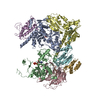
|
|---|---|
| 1 |
|
- Components
Components
-Actin-related protein ... , 6 types, 6 molecules ADEBGF
| #1: Protein | Mass: 47428.031 Da / Num. of mol.: 1 Source method: isolated from a genetically manipulated source Source: (gene. exp.)  Homo sapiens (human) / Gene: ACTR3, ARP3 / Production host: Homo sapiens (human) / Gene: ACTR3, ARP3 / Production host:  |
|---|---|
| #3: Protein | Mass: 34386.043 Da / Num. of mol.: 1 Source method: isolated from a genetically manipulated source Source: (gene. exp.)  Homo sapiens (human) / Gene: ARPC2, ARC34, PRO2446 / Production host: Homo sapiens (human) / Gene: ARPC2, ARC34, PRO2446 / Production host:  |
| #4: Protein | Mass: 20572.666 Da / Num. of mol.: 1 Source method: isolated from a genetically manipulated source Source: (gene. exp.)  Homo sapiens (human) / Gene: ARPC3, ARC21 / Production host: Homo sapiens (human) / Gene: ARPC3, ARC21 / Production host:  |
| #5: Protein | Mass: 44818.711 Da / Num. of mol.: 1 Source method: isolated from a genetically manipulated source Source: (gene. exp.)  Homo sapiens (human) / Gene: ACTR2, ARP2 / Production host: Homo sapiens (human) / Gene: ACTR2, ARP2 / Production host:  |
| #6: Protein | Mass: 16964.180 Da / Num. of mol.: 1 Source method: isolated from a genetically manipulated source Source: (gene. exp.)  Homo sapiens (human) / Gene: ARPC5L / Production host: Homo sapiens (human) / Gene: ARPC5L / Production host:  |
| #7: Protein | Mass: 19697.047 Da / Num. of mol.: 1 Source method: isolated from a genetically manipulated source Source: (gene. exp.)  Homo sapiens (human) / Gene: ARPC4, ARC20 / Production host: Homo sapiens (human) / Gene: ARPC4, ARC20 / Production host:  |
-Protein / Non-polymers , 2 types, 3 molecules C

| #2: Protein | Mass: 41004.781 Da / Num. of mol.: 1 Source method: isolated from a genetically manipulated source Source: (gene. exp.)  Homo sapiens (human) / Production host: Homo sapiens (human) / Production host:  |
|---|---|
| #8: Chemical |
-Details
| Has ligand of interest | Y |
|---|---|
| Has protein modification | N |
-Experimental details
-Experiment
| Experiment | Method: ELECTRON MICROSCOPY |
|---|---|
| EM experiment | Aggregation state: PARTICLE / 3D reconstruction method: single particle reconstruction |
- Sample preparation
Sample preparation
| Component | Name: Arp2/3 / Type: COMPLEX / Entity ID: #1-#7 / Source: RECOMBINANT |
|---|---|
| Molecular weight | Value: 250 kDa/nm / Experimental value: NO |
| Source (natural) | Organism:  Homo sapiens (human) Homo sapiens (human) |
| Source (recombinant) | Organism:  |
| Buffer solution | pH: 7 |
| Specimen | Conc.: 0.25 mg/ml / Embedding applied: NO / Shadowing applied: NO / Staining applied: NO / Vitrification applied: YES |
| Vitrification | Cryogen name: ETHANE |
- Electron microscopy imaging
Electron microscopy imaging
| Experimental equipment |  Model: Titan Krios / Image courtesy: FEI Company |
|---|---|
| Microscopy | Model: FEI TITAN KRIOS |
| Electron gun | Electron source:  FIELD EMISSION GUN / Accelerating voltage: 300 kV / Illumination mode: FLOOD BEAM FIELD EMISSION GUN / Accelerating voltage: 300 kV / Illumination mode: FLOOD BEAM |
| Electron lens | Mode: BRIGHT FIELD |
| Image recording | Electron dose: 60 e/Å2 / Film or detector model: GATAN K2 SUMMIT (4k x 4k) |
- Processing
Processing
| Software | Name: PHENIX / Version: 1.13_2998: / Classification: refinement | ||||||||||||||||||||||||
|---|---|---|---|---|---|---|---|---|---|---|---|---|---|---|---|---|---|---|---|---|---|---|---|---|---|
| EM software | Name: PHENIX / Category: model refinement | ||||||||||||||||||||||||
| CTF correction | Type: PHASE FLIPPING AND AMPLITUDE CORRECTION | ||||||||||||||||||||||||
| Symmetry | Point symmetry: C1 (asymmetric) | ||||||||||||||||||||||||
| 3D reconstruction | Resolution: 4.2 Å / Resolution method: FSC 0.143 CUT-OFF / Num. of particles: 101606 / Symmetry type: POINT | ||||||||||||||||||||||||
| Refine LS restraints |
|
 Movie
Movie Controller
Controller




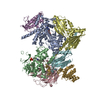
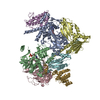
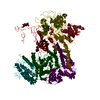
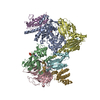

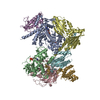
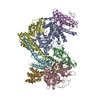
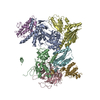
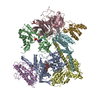
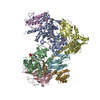
 PDBj
PDBj








